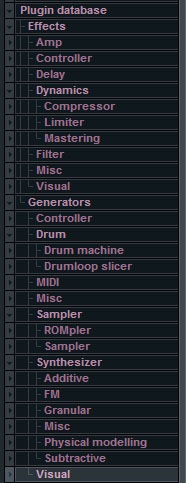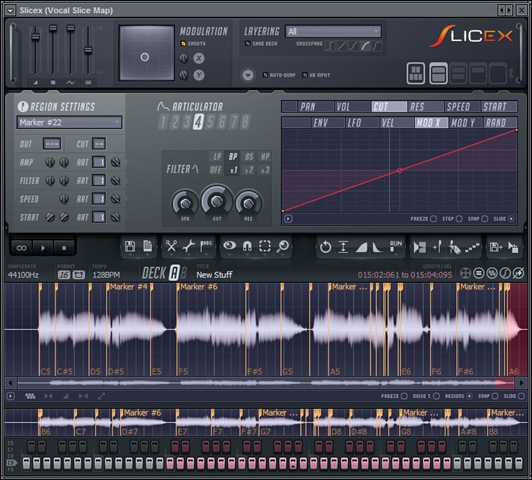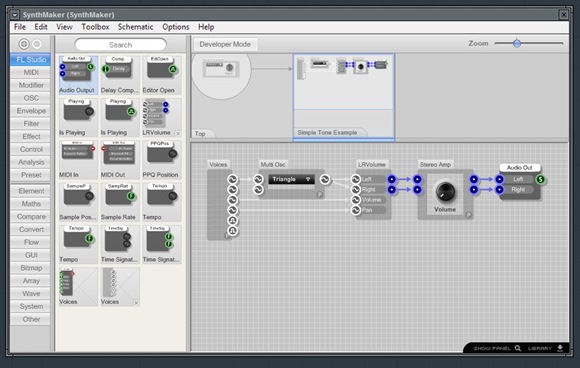FL Studio 8 is here, more or less — as I write this, Release Candidate 3 is available for download, but the final version appears imminent. So, as other tools have matured, why is it that FL is one of those few programs that seems to attract real love?
The press release for the new FL Studio (known to everyone except developer Image-Line as “Fruity Loops”) keeps using the term “DAW.” I have nothing against that, even though DAW as a term has little do with music. (It is the sound English speakers make when they see a cute little lambie or puppy. You know, “dawwwww!….”) It’s a familiar situation: Ableton Live, whose developers came up with the far more descriptive “live sequencing instrument” for their product, felt (rightfully) that Live could compete with more traditional programs and so adopted an otherwise meaningless name. As in that case, FL’s combination of MIDI and audio tools, plug-in hosting and (cough, Reason!) audio recording means you can produce music end to end with it. (Too bad the acronym “DAW” does nothing to hint at what it means.)
What it means to be Fruity
 So, it’s not that FL isn’t a DAW — it’s that it is something else that other programs may not be. I think it needs its own acronym, especially with FL 8 stronger than ever after nearly a decade of ever-maturing releases, a passionate audience, and a dedication to talented developer Arguru, whom the music software community lost last year.
So, it’s not that FL isn’t a DAW — it’s that it is something else that other programs may not be. I think it needs its own acronym, especially with FL 8 stronger than ever after nearly a decade of ever-maturing releases, a passionate audience, and a dedication to talented developer Arguru, whom the music software community lost last year.
Some nominations:
Insane Idiosyncratically-Awesome Music Suite — IIAMS! Wait, no, that sounds like dog food. (Dawwwww!)
Toybox of Sonic Wonders — TOWS.
Beat Bonanza Tracker Sequencer Hybrid — pronounced BbbbbTHHS!, which is the sound I suggest you make at anyone who suggests FL isn’t capable of serious music or “sounds bad.” (Try to produce some spittle in the process.)
(your superior idea here)
Why am I making a fuss over this? Let me see if I can boil it down:
- FL’s approach to sequencing is like nothing else. Rich MIDI sequencing tools meet up with a unusually-focused approach to patterns and loops. It’s really a kind of hybrid between conventional sequencers and music trackers, blending some of the best of each. At first, that can make it confusing to use, but once you wrap your head around the combination, it can be very powerful.
- It’s kind of a ridiculous value. US$50-$100 buys you a perfectly usable version of the program — not a stripped-down, crippled version; you even get some extras. The most you can spend is about US$199-299, or $399 if you absolutely have to have it in a box. Opening that collection is like walking into an art museum of plug-in development, from avant-garde oddities to classics, with all the bundled noisemakers. Only it’s a museum where you can lick the paintings. For soft synth lovers, even the $500 Logic Pro bundle or new $1000 Ableton suite can’t compare in sheer value.
- It keeps getting better. Cheap and free upgrades keep you getting new features. FL has gradually matured from a nifty niche tool to one of the most mature programs out there. And download versions have lifetime free upgrades.
- It’s not for everyone. Some people find the interface maddening. Its kitchen-sink approach may frighten away people who don’t have an appetite for synths and sequencing. And it generally seems to attract a special crowd of FL lovers. But that’s why we love it. And go ahead, hate it if you don’t get it — FL lovers won’t care.
- It’s a reason to use Windows. Because of the way it was developed, FL almost certainly won’t be appearing on the Mac any time soon. But FL can make Windows look better, with rock-solid platform support, Vista support on day one when a lot of other things were broken, and rich ASIO support. It even installs ASIO4ALL by default so you can use the headphone jack on your laptop and other non-ASIO hardware. You could do that yourself. But it shows they care.
The real elephant in the room is FL’s one rival and younger challenger, Ableton Live. But a funny thing happens there. Almost everyone I know who runs Live on Windows spends some time with FL, as well. And this is why the “DAW” label is truly meaningless for people who love music software. Comparing Live and FL just doesn’t make that much sense. Ableton is an experience in minimalism, and we love it for that. FL is deliciously maximalist: arpeggiators and modulation sources seem to come out of the woodwork, and plug-ins and features are there because they’re fun, not because the program couldn’t live without them. You could live without FL itself — but that would be less fun. FL’s finely-detailed sequencing tools, better quantization features, and plug-in value also make it a perfect partner to Ableton, especially given that most of FL’s instruments and effects will run in Live as plug-ins, and FL itself will happily run inside Ableton as either a ReWire client or a plug-in itself. (It’s lightweight enough that that has some appeal.)
Anyway, I digress. But as we line up coverage for the next few months, music making in a few choice programs is really high on the list. And I won’t be covering everything, not because there aren’t lots of wonderful choices, but because as a musician, you ultimately have to choose to use some things and not others. And FL is definitely on my short list. I just enjoy making music with it.
What’s New in FL8
Now having reflected on the philosophy of FL, let’s get to the good stuff — what’s new in 8.
Make your own instruments and effects: FL is bundled with FL SynthMaker, an “FL-native” version of one of the best DIY plugin makers on any platform. You can now build your own MIDI “dashboards”, effects, and instruments without coding and share what you’ve made with other FL users.
Slicex slicer/looper thing: Slicex does some ReCycle-like beat detection and slicing of audio loops so you can re-arrange and time stretch audio, and play from a controller. It’s not Edison, the audio editor-turned-instrument — in fact, Edison is built into Slicex for audio editing. The ability to just drop audio into FL and not only warp it but edit and slice it looks really terrific.
New plug-ins: The Fruity Limiter (compressor/limiter), Wave Candy (for visualizing sound spectrums, complete with an oscilloscope, or just acting as eye candy), Spectrum Analyzer, Peak Meter, and maximizer-enhanced “Soundgoodizer.”
Beefed-up Edison: Edison, an editor/recorder that’s integrated with FL, was already good stuff. Now it also does audio-to-MIDI analysis, records larger files, and lets you mark and dump sound to the Playlist. There’s also an interesting improvement that does gaps filling and drum loop stretching — more on that and the overall workflow here soon.
Envelope Sequencer: This is actually the feature I’m most excited about; stuff like Sytrus and Fruity Love Philter that uses FL’s already-powerful envelope feature now can do arpeggiated patterns more easily.
Always recording: A “background score logger” records all MIDI into a 3-minute buffer so if you’re improvising and come up with an idea, it’s not lost. That 3-minute buffer gave me a chuckle, because hardware synth/keyboards often tout much smaller buffers.
Multilink controller learn for MIDI: This apparently makes it easier to keep your MIDI learn assignments permanent when using more than one controller. It’s not the autolearn sort of feature we’ve seen in tools like Live and SONAR, but it still sounds like good stuff — more detail once I’ve played around with it.
Recording filter: Record audio and note data independently — that should be handy for working with external synths.
OGG export: Groovy. And there are a few mobile players out there that do support OGG. It’s nice to see support for this open format.
Lots of other stuff: Playlist improvements, better clip handling, and lots of little plug-in improvements round out the upgrade.
With built-in, free (with Producer/XXL) support for DIY plug-ins alone, this is a big upgrade — add in the Edison improvements, Slicex, and envelope sequencer, and I’m pretty excited.
I’ve been using FL 8 beta for about a month, but hope to get in deeper and talk more about it soon. And I know you’re interested, too — the FL 8 preview we posted was one of CDM’s most popular stories so far in 2008. Stay tuned.
What’s New in FL Studio 8 [Image-Line]
Get 10% off FL Studio and other Image-Line stuff and support CDM using code BCIIAID485 (except, of course, that the upgrade is going to be absolutely free for a lot of you — which we like!)

